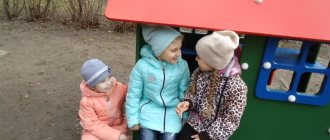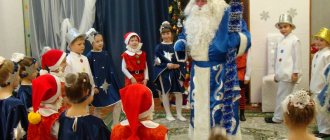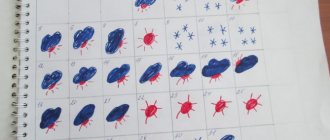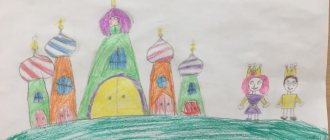Preview:
Reading fiction
Compiled by teacher: Motasova N. G.
Telling a Russian folk tale
Goal: To teach children to perceive the figurative content of the work; consolidate knowledge about the genre, compositional, linguistic features of the Russian fairy tale, continue to develop a poetic ear: the ability to hear and highlight expressive means in the text; bring children to awareness and understanding of figurative expressions.
Ushakova page 156
Conversation about A.S. Pushkin
Goal: To tell children about the great Russian poet; evoke a feeling of joy from the perception of his poems and a desire to hear other works of the poet.
V.V. Gerbova page 25
Memorizing a poem by A.S. Pushkin “The sky was already breathing in autumn.”
Goal: To teach children to expressively read a poem by heart, conveying intonation the sadness of autumn nature, to feel, understand and reproduce the imagery of the poem’s language; expand ideas about the landscape lyrics of A. S. Pushkin
Ushakova page 168
Reading stories about autumn, looking at illustrations.
“What are you sad about in autumn?”
Goal: To consolidate children’s knowledge about changes in autumn nature, to evoke admiration for the colors of autumn nature in the process of looking at illustrations and listening to artistic texts, the desire to express their impressions in figurative words, and to develop a poetic ear.
Ushakova page 158
Memorizing the poem “Autumn” by E. Trutneva.
Ushakova page 161
Telling the Ukrainian fairy tale "The Lame Duck"
Goal: To introduce the Ukrainian fairy tale, to bring to awareness of the artistic images of the fairy tale.
Ushakova page 169
Reading the fairy tale by D. Mamin - Sibiryak
"About the hare - long ears."
Goal: To form a holistic perception of a literary text in the unity of content and artistic form; consolidate children's knowledge about the features of different literary genres; Exercise children in the selection of comparisons, synonyms, antonyms, and cultivate a desire for accurate word usage.
Ushakova page 166
Introduction to a new genre - fable.
Reading the fable by I. A. Krylov “The Dragonfly and the Ant.”
Goal: To introduce children to the fable and its genre features; lead to an understanding of the allegory of a fable, an idea; to cultivate a feeling for the figurative structure of the fable’s language, to understand the meaning of proverbs about work, to connect the meaning of a proverb with a specific situation.
Source
Preparatory group. Senior preschool age. Children 6-7 years old
Summary of a lesson on the perception of fiction in the preparatory group of V. Starodumov “The Fox and the Otter” Educational area: speech development (cognitive)
Topic of
the lesson : introduction to the fairy tale by V. Starodumov “The Fox and the Otter”
Age group: Preparatory group Purpose
of the lesson : understanding the meaning of the story by V. Starodumov “The Fox and the Otter”
through the perception of artistic…
Summary of the lesson in the preparatory group “Reading A. Remizov’s fairy tale “The Voice of Bread” Municipal preschool educational institution “Combined kindergarten No. 13, Shebekino”
Topic: “
Reading a fairy tale by A. Remizov "Bread Voice"
.
Didactic game “I am for you, you are for me
.
Lesson summary for the preparatory group Teacher: Bogachava M.V. First...
Summary of a lesson on familiarization with fiction
Author: teacher Batmanova Natalya Igorevna.
MDOU "Kindergarten No. 55 of a combined type" Ukhta, Komi Republic.
Summary of a lesson on familiarization with fiction in a preparatory school group. Topic: “The fairy tale of K. D. Ushinsky “The pranks of the old woman-winter”
File: lesson notes
Summary of a lesson on familiarization with fiction in a preparatory school group.
Topic: “Fairy tale K. D. Ushinsky “The pranks of the old woman-winter”
Integration of educational areas: “Speech development”, “Cognitive development”, “Socio-communicative development”, “Physical development”
Goal: to systematize children’s ideas about winter as a season.
Program content:
• identify and summarize children’s knowledge about winter and its signs; • consolidate children's knowledge about weather conditions in winter, about the life and adaptation of birds and animals to winter conditions • develop oral speech, attention, thinking; • cultivate a caring attitude towards nature, the ability to see beauty.
Equipment: snowball; portrait of the author; paintings “Old Woman Winter”, “Winter in Our Lands”, “Winter in Warm Regions”; pictures with images of wintering and migratory birds, squares of different colors (white, grey, brown, orange), pictures with images of clothing items.
Progress of the lesson:
- Guys, please listen to the poem: There are deep snows all around, Wherever I look, a blizzard is blowing and swirling. Do you recognize winter? The rivers fell asleep under the ice. Frozen, motionless, the snowdrifts are burning like silver. Do you recognize winter? -By what signs did you recognize winter? (Snow has fallen, a blizzard is sweeping, the rivers have frozen and turned into ice.)
Game "Pick the sign"
(the teacher throws a snowball to the child and asks a question) -What kind of snow? (fluffy, soft, white, light) -Ice, what kind? (hard, transparent, smooth, thick) - What winter? (cold, frosty, windy) -We called adjectives associated with the signs of winter its weather. -One writer calls winter an old woman, that is, he talks about winter as about a person. Why do you think? (The picture “Old Woman Winter” is displayed)
Children: Winter is called an old woman because... (in winter there is a lot of snow, everything around is white like the gray hair of an old man).
This writer’s name is Konstantin Dmitrievich Ushinsky, and Vova will tell you about this writer (a child comes out with a portrait) Konstantin Dmitrievich Ushinsky is a famous Russian educator, teacher. But he taught children not only at school. He wrote many wonderful stories and fairy tales, after reading which children learned kindness, justice and other good qualities.
-So Ushinsky, in his fairy tale for children, calls winter not just an old woman, but a capricious and angry old woman, because old women are kind and caring. Do you want to know why? -Now I’m going to read you a fairy tale. D. Ushinsky “The pranks of the old woman-winter” (pranks are pranks, nasty things)
Reading a fairy tale.
-Guys, what words from the fairy tale do you not understand?
Vocabulary work:
Oak grove, forest; Eaves, zastrha - the lower edge of the roof, forming a canopy; Sleds; Fierce, angry, angry; The fields were powdered and snow fell on the fields.
-So why does the author call winter an angry, grumpy old woman? -What do we do on a walk, warming up from the cold, what winter fun do we know? -Let's build a snowman.
Physical exercise “Snowman”.
- The old woman-winter got angry, she decided to squeeze every breath from the world. -Guys, show me how angry winter is. -Winter blew cold, tore leaves from forests and oak groves and scattered them along the roads. -How did she have to blow to make the leaves fly away from the trees? Let's try. -Who did the old woman reach - winter first of all, at the very beginning? -Why didn’t she manage to freeze the birds?
Children: Some flew to warmer climes, while others stayed for the winter.
-What are the names of birds that fly away to warmer climes?
Children: Birds that fly to warmer regions are called “Migratory”.
-Right! What are the names of birds that stay for the winter?
Children: Birds that remain for the winter are called “winterers.”
-Well done! Now let’s play the game “Migratory - Wintering”. -You have two pictures in front of you. One shows winter in our area, and the other shows the warm southern region. And here are images of birds that need to escape the winter: fly alone to warmer climes, if they are migratory birds, and wintering birds will remain with us for the winter. —Are the animals afraid of winter? (The animals were not afraid: some have warm fur coats, others hid in deep holes; a squirrel in a hollow is gnawing nuts, a bear is sucking a paw in a den; a little bunny is jumping and warming himself, and horses, cows, and sheep have long been chewing ready-made hay in warm barns, They drink warm swill.)
-Let's play the game “Enchanted Animals” -The old woman-winter bewitched the animals and turned them into multi-colored pieces of ice. -You can disenchant them if you name who is white, orange, gray and brown)
Children are shown squares of different colors - corresponding to the color of the animals, the children guess (white - hare, gray - wolf, hedgehog, squirrel, orange - fox, brown - bear).
-Well done, you have disenchanted the animals! -What about the fish? Are they afraid of winter?
Children: No! They went to the deep end.
-Can fish talk?
Children: No! Pisces can't talk.
“I’ll also try to be a fish now, and you can guess from my lips what sounds I make.” (A, O, U, I) -What sounds are these, vowels or consonants? Why? -How do people escape from the old woman of winter?
Children: People dress warmly, rub their hands, face, ears. They heat the stove.
-And to stay completely warm, you need to wear winter clothes. (Pictures with images of clothes are laid out. Children choose pictures with winter clothes, naming them) - Well done! What winter activities were mentioned in the fairy tale?
Children: Skiing, sledding, skating, snowball fights, building a snow fort...
-Are children afraid of winter?
Children: No! They are happy and warm.
- Guys, what happened to the old woman in winter when she saw that she couldn’t take anything, neither birds, nor animals, nor people, nor small children.
Children: Winter cried.
-Why did she cry? -What do you think are the tears of winter? -Why are you crying? -The author calls winter an old woman, but what would you call it affectionately?
Reflection:
-What is the name of the fairy tale, author? -Who and what can you tell about the pranks of the old woman of winter?
On the topic: methodological developments, presentations and notes
Introduce children to the writer M. Prishvin and his stories “Golden Meadow”, “Guys and Ducklings”, Squirrel Memory.
The program points out the need to introduce children to their native culture, memorize nursery rhymes, songs, chants with children, and develop children’s interest in children’s folklore. For most children.
The goals, objectives, and forms of work to introduce children to reading are revealed. How classes are conducted in different age groups. And also working with parents.
"Development of emotional responsiveness in children of senior preschool age through the means of fiction (type of children's activity - perception of fiction and folklore)."
Reading L. Tolstoy’s story “The Jump” in a preparatory school group. Getting to know the author and the work.
Topic: “Learning songs - nursery rhymes”, “Boy, little finger, where have you been...” Form of work: learning. Group: 1st junior.
Summary of educational activities on the perception of fiction and folklore based on the technology of productive reading and listening on the topic “The Beauty of the Winter Forest” using the example of G. Skrebitsky’s fairy tale for children.
Abstract of GCD on the perception of fiction in the preparatory group
“Which leaf? - I think. “Look, what a fat and mustachioed muzzle.” “What does this have to do with the muzzle? My heart is heavy. I’m lying here under the leaves, feeling sad.” “Why are you sad, autumn cat?” (Why did the author decide that the cat was sad?) “It’s somehow a pity. So the birds fly away. You won't understand this." (The cat probably liked to hunt birds). Until the evening the cat lay in the sunflowers, sad. It's getting colder. The cat jumped up, arched his back, snorted and ran into the house. (What will happen next, what do you think?) . I immediately climbed onto the stove. “I’ll stop being an autumn cat,” he grumbled. “Now I’ll become winter.” That night the first snow fell.
Abstract of GCD on the perception of fiction in the preparatory group
Svetlana Baranok
Abstract of GCD on the perception of fiction in the preparatory group
Summary of GCD
in the preparatory group
on the perception of fiction
"The Tale of the Dead Princess and the Seven Knights"
— Continue to introduce children to the works of A. S. Pushkin.
— To promote the development of the ability to identify the main characters and the sequence of the main episodes of a literary text .
— Enrich children’s vocabulary with words denoting objects and phenomena from the fairy tale.
— Contribute to the development of children’s speech and communication activity while discussing a fairy tale.
— Develop memory, imagination, imaginative perception .
— Continue to improve the dialogical and monologue form of speech, the ability to meaningfully and expressively convey a literary text in the process of telling an excerpt from a fairy tale by role.
Educational:
— Foster a love of books , evoke an emotional attitude towards the characters through the use of expressive means (poetry, music, author’s illustrations for fairy tales)
.
— Form friendly relationships between children, the ability to negotiate, help each other, work in a group ;
Methods and techniques:
- Game moment, search questions, guessing riddles, reading proverbs, artistic expression , showing a presentation, homework,
— Introducing children to the life and work of A. S. Pushkin.
— Organization of the library “Creativity of A. S. Pushkin”
— Reading the works of A. S. Pushkin: “The Tale of the Dead Princess and the Seven Knights”
,
“The Tale of the Fisherman and the Fish”
,
“The Tale of the Golden Cockerel”
,
“The Tale of Tsar Saltan”
, his poems.
— Watching cartoons based on the fairy tales of A. S. Pushkin.
— Creation of the album “Tales of A. S. Pushkin”
.
GCD artistic creativity : drawing the characters of “The Tale of Tsar Saltan”
,
"Cover for a book of fairy tales"
.
Modeling “My favorite fairy-tale hero”
Surprise book, portrait of A. S. Pushkin, ICT, CD with the cartoon “The Tale of the Dead Princess and the Seven Knights”
, cut-out pictures - puzzles with scenes from a fairy tale, sheets with fairy tale characters drawn on them with wax crayons, paints, brushes, sippy cups.







